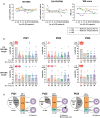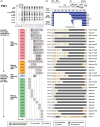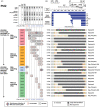Long-term persistence of transcriptionally active 'defective' HIV-1 proviruses: implications for persistent immune activation during antiretroviral therapy
- PMID: 37555786
- PMCID: PMC10615727
- DOI: 10.1097/QAD.0000000000003667
Long-term persistence of transcriptionally active 'defective' HIV-1 proviruses: implications for persistent immune activation during antiretroviral therapy
Abstract
Objectives: People with HIV-1 (PWH) on effective antiretroviral therapy (ART) continue to exhibit chronic systemic inflammation, immune activation, and persistent elevations in markers of HIV-1 infection [including HIV-DNA, cell-associated HIV-RNA (CA HIV-RNA), and antibodies to HIV-1 proteins] despite prolonged suppression of plasma HIV-RNA levels less than 50 copies/ml. Here, we investigated the hypothesis that nonreplicating but transcriptionally and translationally competent 'defective' HIV-1 proviruses may be one of drivers of these phenomena.
Design: A combined cohort of 23 viremic and virologically suppressed individuals on ART were studied.
Methods: HIV-DNA, CA HIV-RNA, western blot score (measure of anti-HIV-1 antibodies as a surrogate for viral protein expression in vivo ), and key biomarkers of inflammation and coagulation (IL-6, hsCRP, TNF-alpha, tissue factor, and D-dimer) were measured in peripheral blood and analyzed using a combined cross-sectional and longitudinal approaches. Sequences of HIV-DNA and CA HIV-RNA obtained via 5'-LTR-to-3'-LTR PCR and single-genome sequencing were also analyzed.
Results: We observed similar long-term persistence of multiple, unique, transcriptionally active 'defective' HIV-1 provirus clones (average: 11 years., range: 4-20 years) and antibody responses against HIV-1 viral proteins among all ART-treated participants evaluated. A direct correlation was observed between the magnitude of HIV-1 western blot score and the levels of transcription of 'defective' HIV-1 proviruses ( r = 0.73, P < 0.01). Additional correlations were noted between total CD8 + T-cell counts and HIV-DNA ( r = 0.52, P = 0.01) or CA HIV-RNA ( r = 0.65, P < 0.01).
Conclusion: These findings suggest a novel interplay between transcription and translation of 'defective' HIV-1 proviruses and the persistent immune activation seen in the setting of treated chronic HIV-1 infection.
Conflict of interest statement
There are no conflicts of interest.
Figures





Comment in
-
'Zombie' proviruses in the spotlight: exploring the dark side of HIV persistence.AIDS. 2023 Nov 15;37(14):2239-2241. doi: 10.1097/QAD.0000000000003721. Epub 2023 Oct 26. AIDS. 2023. PMID: 37877277 No abstract available.
References
-
- Ingle SM, May MT, Gill MJ, Mugavero MJ, Lewden C, Abgrall S, et al. Antiretroviral Therapy Cohort Collaboration. Impact of risk factors for specific causes of death in the first and subsequent years of antiretroviral therapy among HIV-infected patients. Clin Infect Dis 2014; 59:287–297. - PMC - PubMed
-
- Boulware DR, Hullsiek KH, Puronen CE, Rupert A, Baker JV, French MA, et al. INSIGHT Study Group. Higher levels of CRP, D-dimer, IL-6, and hyaluronic acid before initiation of antiretroviral therapy (ART) are associated with increased risk of AIDS or death. J Infect Dis 2011; 203:1637–1646. - PMC - PubMed
Publication types
MeSH terms
Substances
Grants and funding
LinkOut - more resources
Full Text Sources
Medical
Research Materials

